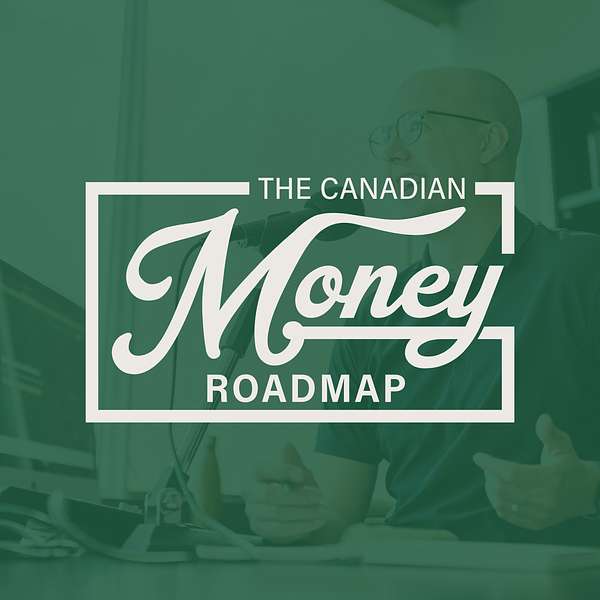
The Canadian Money Roadmap
Invest smarter, master your money, live & give more
The Canadian Money Roadmap
Financial Strategies for the End of 2023
In this episode, I'll discuss the new TFSA contribution limit for 2024 and why it might be a good idea to withdraw funds now if you're planning to use them early next year. We'll also look at the First Home Savings Account (FHSA), and the importance of opening this account in the year you wish to use the contribution room. We'll additionally explore the RSP contribution room for 2024, pegged at $31,560, and why your earned income is the only income that counts towards this room.
I'll also go over the process of tax-loss harvesting, and the year-end distributions for mutual funds and ETFs in non-registered accounts. We'll also talk about how making charitable donations can work in your favour and a reminder to exhaust your workplace benefits before the year concludes.
🌳 Connect with Evan and Cedar Point Wealth | Services and Pricing
🗣️ I want to hear from you! Record your comment or question here and you could be featured on an upcoming episode of the podcast
✨ Get your money organized - Your Full Financial Picture Spreadsheet
Hello and welcome back to the Canadian Money Roadmap podcast. I'm your host, evan Newfield. On today's episode, I'm going to go through a few things that you should keep in mind before we get to the end of the year of 2023 and look forward to 2024. Alright, let's hop right into the episode here. I wanted to give a few updates regarding some changes that happen. A lot of them related to taxes, some of them TFSAs, and just some things that you can keep in mind that might be relevant for you as you finish out 2023. First things first. I think I've talked about it on the podcast already, but it is now official the new TFSA room for 2024 is going to be $7,000. In 2023, it was $6,500. And so anyone who's over the age of 18 in some provinces, 19, but anyone that qualifies to open a TFSA in 2024, you're going to get $7,000 of room Again. If you have not taken advantage of your previous room or you don't have $7,000 to contribute next year, it's okay because that room carries forward indefinitely into the future, but maybe in another year where you do have more income, maybe you're in child raising mode, like my wife and I right now, and you don't have a ton of disposable income. That's totally fine, because the TFSA is a tool that you can use in the future. So $7,000 is available to you, coming up in January. So you get that room in January. You don't get that room now, even though the room is announced Again. You have to wait till January to use it. Another year-end thing to keep in mind if you're planning on making a withdrawal from your TFSA, maybe you're using it for short term savings or a combination of goals and you know that you're going to be spending that money, perhaps early on in 2024. If you make your withdrawal now, in 2023, the way that the re-contribution rules work is that you can put that money back in once the new year rolls over. But if you make that withdrawal in the new year, you have to wait the full calendar year again to be able to put that money back in. So, say, you're someone that's maximized your TFSA, you might need to make a withdrawal from it early next year. Maybe consider doing it now so that you have the capability to reinvest that money early on in 2024 whenever you'd like. So, for example, say you have maximized your TFSA and you wanted to withdraw $5,000, if you did that now here in December you sell your investment or whatever it's in maybe it's just in cash in a high interest savings account or something like that If you withdraw your $5,000 now in 2023, come January 1st, you can put your $5,000 back in so that contribution room resets in January. So if you're thinking of making a withdrawal, maybe consider doing it now. Item number two is related to the first home savings account, the FHSA. That one's an acronym that's a bit annoying to use, but the FHSA. I would recommend that, if you are not currently a homeowner, that you consider opening one of these plans. Note, I didn't say contribute to the plan. That would maybe be a little bit different, but opening it just gives you more options and I'll explain why. Kind of like with the TFSA and we talked about the $7,000 being able to be carried forward into the future or any unused contribution room being able to be carried forward. With the TFSA, that's just based on your age where it's. With the first home savings account, you only carry forward room based on the account being open, and so to be able to use $8,000 of contribution room for the 2023 year or in a year in the future, you have to have it open in the 2023 year. So if you're not currently a homeowner, if it's even remotely on your radar, if you're in a high tax bracket and you're not a homeowner, take a look at the FH, f, h, s A. I'm having a hard time even saying it. It's a bad acronym, we got too many acronyms. But once you have the plan open next year, if you have some cash or you've got maybe money in your TFSA that you're planning on using for a house, you can actually take money out of your TFSA and contribute it to your FHSA. But keep in mind with the first home savings account that when you make your contribution you get the tax benefit in that year and you don't have the same first 60 day privileges like you would with an RSP. So for tax purposes it functions like an RSP, where you put money in and you get a tax deduction against your income. So whatever your marginal rate is times, whatever you put into the plan, you get that benefit, but only for the calendar year. So you cannot make an oopsie daisy contribution later on in 2024 for the 2023 year a little bit complicated. So you have to make that decision at least to open it. But if you want to get the tax break for the 2023 tax year. You'll have to make that contribution before the end of 2023, december 31st of this year Hopefully a little bit before that, because sometimes there's processing delays with all the holidays and things like that. So I would encourage you if you're going to do that, do it sooner than later. That brings me to RSPs. So the RSP room gets adjusted every year with an inflation factor, and so the room for next year is going to be $31,560. So that is the maximum contribution room. So the way that an RSP actually accumulates is it's 18% of your earned income. So things like dividends aren't earned income. So self employed people sometimes don't get RSP room if they take dividends out of a company or something like that. If you earn dividends from investment portfolio, that doesn't count as earned income for RSPs. But if you're just traditionally employed and you got to paycheck from your employer, you will earn RSP contribution room at the rate of 18% of that income. So the maximum room is applicable here for people that make a little bit over $175,000. I'm just doing the backwards math there of 31,560 divided by 18%, and then you get the maximum contribution room there. So, again, just like TFSAs, where that carries forward. Your RSP contribution room carries forward indefinitely as well. It doesn't ever have to be used, but you can use it at any point in the future, perhaps at a time that's more advantageous when you're in a higher tax bracket. So, unlike the FHSA, where you have to complete that purchase by the end of the year, the RSP's got this weird wrinkle where, if you Would like to make a contribution for the 2023 tax year, you still have the first 60 days of 2024 to make that decision. So that kind of gives you enough time to get your ducks in a row and count up your income. Perhaps you have income from multiple sources. You can actually spend a bit of time and and and make a really educated decision on whether making RSP contribution makes sense for you, because you'll have all the information you need, based on the income that you have for that calendar year. So yeah, you've got time, and so that's applicable for this year, just like any other year. The first 60 days you can make an RSP contribution. So there's no panic on RSPs, but start thinking about it at the very least. Number four of things that you should consider before the end of the year tax law selling I don't talk about this one too often because it's not always applicable to everybody. But tax law selling is just the idea that when you're in a non registered account again, this is not applicable to someone who's invested in TSA or an RSP or a lira pension plan anything any of these other types of plans only in a non registered account, because in a non registered account you pay tax when you make money. And you make money in a few different ways you can earn it from dividends, you can earn it from interest and you can earn it from capital gains. Now, the other side of capital gains is capital losses, and from time to time that happens. All depends on how you're invested and and things like that. But the market goes up, the market goes down. Sometimes you're looking at the end of the year and you might have an investment that's currently in a capital loss. So what happens is so say, you buy something for a hundred bucks and now it's worth 80, in this case here, if you sold that investment and Purchased one that's meaningfully different, you can't just like buy and sell within the same period of time. There's some rules on that, I won't get into that today. But that $20 loss in this case, you'd be able to use that to offset capital gains, either indefinitely into the future or you can actually go backwards three years. So there's some cool scenarios that you can kind of monkey around with, where someone might have an investment portfolio that might have Some losses here and there from time to time, but maybe a couple of years ago he sold an investment property at a capital gain. You could go back and you could refile and get some money back from those taxes that you would have had in that previous year Based on capital losses that you had this year. There's some cool things that you can do there, but because there are some really specific rules about what you can and cannot do in that regard, I would highly recommend that you work with a professional on that, maybe seek the help of an accountant and just make sure that you're doing the right thing. When it comes to Tax loss, selling sometimes is called tax loss harvesting same kind of thing. Number five of Things that are probably going to be relevant for you before the year end would be year-end distributions. So if you are invested in mutual funds and ETFs, more so relevant for mutual fund investors Mutual funds and ETFs have to distribute their income that's earned within the structure to unit holders. So if you're an investor in a mutual fund and that mutual fund earns income through dividends, interest or capital gains, at the end of the year they have to distribute that back to you, and so this is again only relevant to you from a tax perspective if you're in a non-registered account, because you do not have to pay any sort of taxes on Distributions if you have them inside a TFSA or an RSP. It's not really that relevant. So this is mostly just for people that are in Non-registered accounts. So the way that it works is that, because a mutual fund could be, say, a balanced fund, which means there's gonna be some stocks and some bonds, if that fund is particularly active and there's some buying and selling that happens in there, there's probably some capital gains. That could happen from time to time. If they own bonds, they'll earn interest income, and if they own stocks, they'll probably have some dividend income in there as well. Okay, and so when this income is earned within the mutual fund structure, it is then Distributed to unit holders at the end of the year. Sometimes they do it monthly, sometimes quarterly. Annually is really common, because there are all those different types of income. You might have a distribution that is just a flat, say, hundred dollars, but the components of that distribution might be very different. So it might be 20 bucks as dividends, 20 bucks is interest and 60 of it is capital gain. Hopefully I'm doing my math right there. So there could be a variety of different income types earned within there. Why does that matter? Because all of them are taxed differently. So at the end of the year, if you're in this case where you have a mutual fund owned in a non-registered account, you're going to get a slip for it, a tax slip, and it will give you a breakdown of all the different types of income that's earned within there. Foreign income is another thing actually, too, because if you're invested in a globally diversified portfolio, you might have dividends and interest earned by foreign and non-Canadian investments, and so those are taxed very similarly to interest at your marginal tax rate. But anyways, this is really important to kind of keep this in mind. There's a lot of other factors to consider when it comes to year-end distributions, but the main point of confusion that comes up for people is that when a distribution happens, more often than not it gets reinvested back into the fund. Super, super common. It works kind of like almost like a dividend, the way that it decreases the price but you buy more units at that new lower price, so the net effect is zero, right? So from an investment return standpoint, receiving a distribution doesn't actually impact your return at all. There's going to be some weird stuff on your charts if you follow any of that, because the price adjusts based on the distribution but you're buying more units at that new lower price, so the net amount is a wash, but there is a taxable component to it. Okay, so, even though money didn't hit your bank account and there was no withdrawal from the plan, you're still going to receive a tax slip and you'll have taxable income from those year-end distributions. Again, this is only in a non-registered account. If you have questions about this, talk to your advisor. You can inquire with the fund company. There's all sorts of different ways that you can get more information about this. But, yeah, keep an eye out for a year-end tax slip related to distributions. Number six of things that you could keep in mind before the end of 2023, and that is taking a look at charitable donations. So you can make donations to a registered charity and receive a tax credit for that. It's really common around this time of year, just because it's kind of the giving season and so many people like to make charitable donations at the end of the year and there's a lot of matching campaigns that happened and, yeah, this is really popular time for people to do year-end charitable giving. There's no first 60-day rule or anything like that, and so if you're hoping to get a tax credit for a charitable donation, you have to make that donation before the end of the calendar year. I just had an episode recently with my colleague, jordan Arndt, about some of the specifics around charitable giving. Feel free to go back and look at that episode. It's titled what to Get the Person that has Everything, something like that. I think I remember the title. But yeah, there's lots of cool things that you can do with charitable giving at the end of the year. I'm sure there's many other things that I perhaps missed here, but the last one that's on my list here is taking a look at your workplace benefits and seeing if there's anything that you could or need to use up by the end of the year. Things like sometimes your benefits reset, sometimes vacation time disappears. At the end of the year there could be some sort of health spending account, all sorts of things. People forget about this stuff all the time, so just have a quick look at that. Maybe you need a little December massage. You can use that up as part of your benefits. But just take a look and see if there's anything within your benefits program that would disappear at the end of the year If you didn't use it. If you need to use it, that would be as good a time as any. So, anyways, these are just a few things that you can keep in mind before the end of the year and as we look towards 2024. So the first one was just that update on TFSAs and the new contribution room for next year, and also the withdrawal concept of making withdrawal this year so that you can get your contribution room back right away in January of the following year. So if you're thinking about doing a TFSA withdrawal, think about that Now. Next one would be opening an FHSA first home savings account so that you can get the benefit of carry forward room on that plan. You don't need to put money into it yet, unless your brokerage or whatever requires you to do that. That's fine, but from a CRA standpoint there's no actual contribution requirement there to open up the plan. Number three is taking a look at your RSPs getting the new maximum for next year. You've got some time, though, to make a contribution, because you have that first 60 days of next year to make that contribution. Taking a look at tax loss harvesting or tax loss selling, in case you had a large taxable event in the past, depending on how you're invested. If you do rebalancing or things like that, it might be a decent time to take a look at that here, just so that you can take advantage of the losses for future gains. I did a little roundup on year end distributions. If you are invested in a non-registered account in mutual funds or ETFs just something to be aware of that. Even though you might not receive any money in your account and you might just have reinvested distributions there, you might have a little bit of extra taxable income that perhaps you were not prepared for. So just keep an eye out for that. You can often get estimates from fund companies in advance of them actually doing that, just so you have a little bit of forewarning anyways. The last couple here are donations and then using up your benefits at work, so hopefully these are helpful as we go into the end of the year. If you liked this episode or any of my other episodes, feel free to leave a rating or review on Apple Podcasts. I really appreciate you being here. Thanks so much for listening and we will see you next week. Thanks for listening to this episode of the Canadian Money Roadmap Podcast. Any rates of return or investments discussed are historical or hypothetical and are intended to be used for educational purposes only. You should always consult with your financial, legal and tax advisors before making changes to your financial plan. Evan Neufeld is a certified financial planner and registered investment fund advisor. Mutual funds and ETFs are provided by Sterling Mutuals Inc.
Podcasts we love
Check out these other fine podcasts recommended by us, not an algorithm.

The Rational Reminder Podcast
Benjamin Felix, Cameron Passmore, and Dan Bortolotti
Animal Spirits Podcast
The Compound
The Intelligence from The Economist
The Economist
The Compound and Friends
The Compound
Trillions
Bloomberg
The Journal.
The Wall Street Journal & Spotify Studios
Standard Deviations with Dr. Daniel Crosby
Dr. Daniel Crosby
